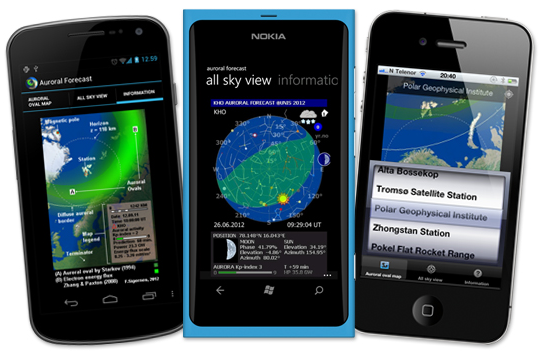| ☰ Menu | The Auroral Forecast goes public |

Screen shots of the Auroral Forecast app on 3 different platforms: Android, Windows and iPhone.
Image: Appex.no.
The Auroral forecast at KHO is now available for all smart phone platforms including Android, iPhone and Windows.
The apps were released on Andøya Rocket Range 50 years anniversary, to honor their contribution to space physics and cooperation with UNIS.
The app is part of an on-going research program to improve forecasts of the aurora and make it available to the public for free. The original android app has been updated and converted by the company Appex.no to work on iPhone and Windows phones. It can be downloaded through Windows Market place, Apple App Store and Google Play. The program forecasts up to +1 hour in time the size and location of the auroral ovals or the impact zone of energetic particles from the Sun, i.e. a green circular belt of auroral emissions around each geomagnetic pole. It also includes local weather, solar illumination and star charts from 7 well known auroral observatories. It is based on the well known relationship between the morphology of the auroral and the level of geomagnetic activity. This allows us to develop models of the location of the auroral borders, independent of the vagaries of auroral observations. In addition, new models have evolved that use data of particle precipitation measured by polar orbiting satellites. Two methods by Starkov (1994) and Zhang & Paxton (2008) are used to mathematically calculate the size and location of the auroral oval mapped onto a solar illuminated Earth globe (Sigernes et al. 2011a; 2011b). Both models only use planetary Kp index (0...9) and time as input, which makes them ideal candidates for forecasting aurora. The predicted Kp value is estimated by the Space Weather Prediction Centre (NOAA-SWPC) using satellites that are located upstream in the solar wind. |
|
References
F. Sigernes, M. Dyrland, P. Brekke, E. K. Gjengedal, S. Chernouss, D. A. Lorentzen, K. Oksavik and C. S. Deehr, Real time aurora oval forecasting – SvalTrackII, Optica Pura y Aplicada (OPA), 44, 599-603, 2011a. F. Sigernes, M. Dyrland, P. Brekke, S. Chernouss, D.A. Lorentzen, K. Oksavik, and C.S. Deehr, Two methods to forecast auroral displays, Journal of Space Weather and Space Climate (SWSC), Vol. 1, No. 1, A03, DOI:10.1051/swsc/2011003, 2011b. Starkov G. V., Mathematical model of the auroral boundaries, Geomagnetism and Aeronomy, 34 (3), 331-336, 1994. Zhang Y., and L. J. Paxton, An empirical Kp-dependent global auroral model based on TIMED/GUVI data, J. Atm. Solar-Terr. Phys., 70, 1231-1242, 2008.
Acknowledgement
We wish to thank the National Oceanic and Atmospheric Administration (NOAA) - Space Weather Prediction Centre for allowing us to download the predicted value of the estimated Kp index every 15 minutes. The work is financially supported by The Research Council of Norway through the project named: Norwegian and Russian Upper Atmosphere Co-operation On Svalbard part 2 # 196173/S30 (NORUSCA2), the Nordic Council of Ministers: Arctic Cooperation Programme # A10162, and COST action ES0803. |